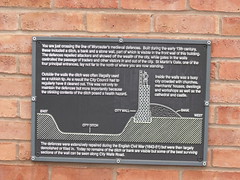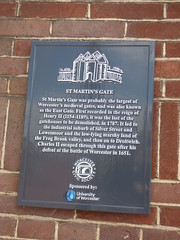St Martin's Gate
Commemorated on 2 plaques
You are just crossing the line of Worcester's medieval defence's. Built during the early 13th century, these included a ditch, a bank and a stone wall, part of which is visible in the front of this building. The defences repelled attackers and showed off the wealth of the city, while gates in the walls controlled the passage of traders and other visitors in and out of the city. St Martin's Gate, one of the four principal entrances, lay not far to the north of where you are now standing. Outside the walls the ditch was often illegally used as a rubbish tip. As a result the City Council had to regularly have it cleaned out. This was not only to maintain the defences but more importantly because the stinking contents of the ditch posed a health hazard. Inside the walls was a busy city crowded with churches, merchants' houses, dwellings and workshops as well as the cathedral and castle. The defences were extensively repaired during the English Civil War (1642-51) but were then largely demolished or filled in. Today no remains of the ditch or bank are visible but some of the best surviving sections of the wall can be seen along City Walls Road.
Footbridge above City Walls Road, Worcester, United Kingdom where it was near
St Martin's Gate St Martin's Gate was probably the largest of Worcester's medieval gates, and was also known as the East Gate. First recorded in the reign of Henry II (1154-1189), it was the last of the gatehouses to be demolished, in 1787. It led to the industrial suburb of Silver Street and Lowesmoor and the low-lying marshy land of the Frog Brook valley, and then on to Droitwich. Charles II escaped through this gate aftr his defeat at the battle of Worcester in 1651.
Corn Market (near the end of New Street), Worcester, United Kingdom where it was demolished (1787)


